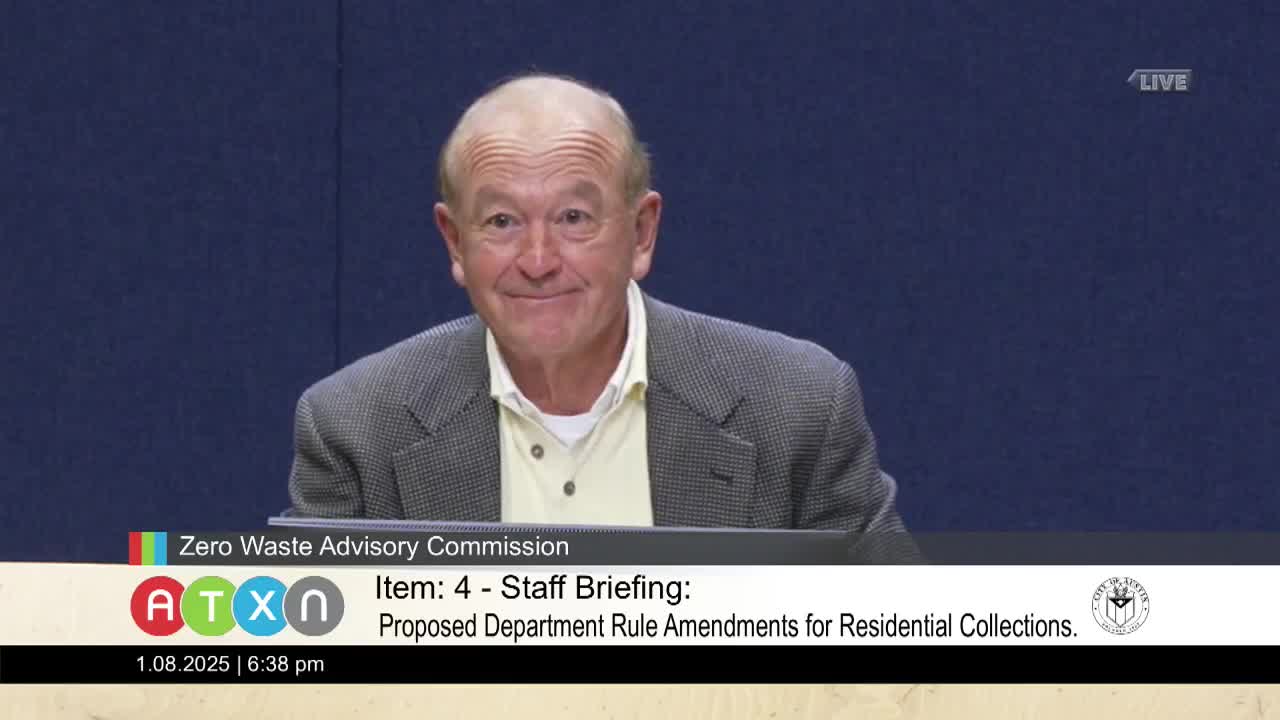ARR staff walk commissioners through resource recovery report definitions, diversion math and reuse programs
January 08, 2025 | Austin, Travis County, Texas
This article was created by AI summarizing key points discussed. AI makes mistakes, so for full details and context, please refer to the video of the full meeting. Please report any errors so we can fix them. Report an error »

Deputy Director Ted Horton presented an overview of the monthly waste and organics reports, explaining the definitions behind each report row and the math used to calculate diversion and subtotals.
Horton described how the Resource Recovery Center and the adjacent household hazardous waste (HHW) facility together compose the Recycled Reuse Drop-Off Center (RRDOC) and showed sample photos and definitions to help commissioners interpret report rows such as tons of curbside trash, curbside bulk, curbside recycling residuals (MRF residuals), RRDOC tons and HHW tons.
He explained the accounting adjustments the report uses to avoid double counting materials that are collected curbside and subsequently dropped at the RRDOC. Horton emphasized that the published curbside diversion percentage excludes RRDOC materials by design and said that as ARR begins to collect additional materials curbside the curbside diversion percent should increase and better reflect total diversion.
Horton also highlighted operational reuse programs: Austin's paint program (where residents may request recovered paint), a reuse store for suitable HHW items, processing that produces Dillo Dirt (compost), densifying operations for materials such as reclaimed styrofoam and the program to recycle worn-out carts back into parts or other applications.
When a commissioner asked why many categories showed lower tons in 2024 than in 2023, Horton said several factors may contribute, including pandemic-era changes in consumer behavior and vehicle-miles-traveled patterns, and noted the refuse business historically tracks closely to broader economic activity; he deferred detailed analysis to the next meeting when staff will present rolled-up diversion rates.
Horton also noted the report records a line for animal pickup tons and directed residents to the Austin request form for animal pickups.
Horton described how the Resource Recovery Center and the adjacent household hazardous waste (HHW) facility together compose the Recycled Reuse Drop-Off Center (RRDOC) and showed sample photos and definitions to help commissioners interpret report rows such as tons of curbside trash, curbside bulk, curbside recycling residuals (MRF residuals), RRDOC tons and HHW tons.
He explained the accounting adjustments the report uses to avoid double counting materials that are collected curbside and subsequently dropped at the RRDOC. Horton emphasized that the published curbside diversion percentage excludes RRDOC materials by design and said that as ARR begins to collect additional materials curbside the curbside diversion percent should increase and better reflect total diversion.
Horton also highlighted operational reuse programs: Austin's paint program (where residents may request recovered paint), a reuse store for suitable HHW items, processing that produces Dillo Dirt (compost), densifying operations for materials such as reclaimed styrofoam and the program to recycle worn-out carts back into parts or other applications.
When a commissioner asked why many categories showed lower tons in 2024 than in 2023, Horton said several factors may contribute, including pandemic-era changes in consumer behavior and vehicle-miles-traveled patterns, and noted the refuse business historically tracks closely to broader economic activity; he deferred detailed analysis to the next meeting when staff will present rolled-up diversion rates.
Horton also noted the report records a line for animal pickup tons and directed residents to the Austin request form for animal pickups.
View full meeting
This article is based on a recent meeting—watch the full video and explore the complete transcript for deeper insights into the discussion.
View full meeting
